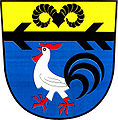Straka from Nedabylic
The Straka von Nedabylic , also Straka von Nedabilic ( Czech Strakové z Nedabylic ) are an extinct Bohemian noble family. The Vladikengeschlecht was Johann Peter Straka of Nedabylic in the second half of the 17th century in the Bohemian Mr. Booth raised and in 1692 the title of Count. The family died out in 1769 with the death of Wenceslaus Georg Adam Straka von Nedabylice. The Straka of Nedabylic were tribal and heraldic related to the families of Dašice and Král from Dobrá Voda. They have no connection with the knight family of the Straka von Hohenwald .
history
The ancestral seat of the Vladiken Straka was the fortress Nedabylice in East Bohemia; the village of Nedabylice , northeast of Chýšý , died out in the 16th century.
The first verifiable representative of the family was Bransud of Nedabylic in 1376. Jan Straka von Nedabylic, who is documented between 1447 and 1469, was in the service of the robber baron Jan Kolda von Náchod and was able to acquire several smaller goods, including Studnice and Jeníkovice . Johann Peter Straka von Nedabylice (1645–1720) is considered the most important representative of the sex .
With Wenzel Georg Adam Straka von Nedabylic, the line died out in the male line in 1769. The name of the family was continued by the Straka von Königsfeld, at the beginning of the 19th century this family also became extinct.
The possessions of the Straka of Nedabylic included u. a. the goods Malobratřice, Třtice, Šonov , Libčany , Okrouhlice and Ober Weckelsdorf .
Relatives
The royal privy councilor and chamberlain Johann Peter Straka von Nedabylice (1645-1720) was first raised to the Bohemian gentry and in 1692 to the count. In his will, laid down in 1710, he ordered the establishment of the Straka Foundation for the establishment of a noble knight academy for young impoverished aristocrats. In addition to his estates Liebtschan , Okrauhlitz and Ober Weckelsdorf , whose value was estimated at 377,000 guilders, cash assets of 38,542 guilders also flowed into this . In 1782, by order of Emperor Joseph I , an annual scholarship was awarded from the proceeds of the three estates for studying Bohemian youths of the aristocratic class in all kk hereditary lands, which was granted in the lower schools in the amount of 200 guilders and in the higher schools in the amount of 300 guilders has been. The benefactor's relatives were the main beneficiaries, but also other young Bohemian nobles from the gentry and knighthood. The right of presentation was mutually due to the emperor and the Bohemian estates. The Straka Foundation began its work in 1814. The prestigious Straka Academy was built from the foundation's capital between 1891 and 1896 on the Lesser Town in Prague in the former Jesuit gardens in Klárov. The neo-baroque building was one of the most modern in Prague and the first to have central heating. The building of the former Straka Academy is now the seat of the Czech government.
Other well-known representatives were Peter Nikolaus Straka von Nedabylice († 1720), from 1695 chief clerk of the Kingdom of Bohemia, and Johann Karl Straka von Nedabylice, who was raised to the rank of count in 1732. The heraldist Adalbert Král von Dobrá Voda was related to the family.
coat of arms
The coat of arms shows a silver rooster walking to the right with black tail feathers on a blue shield with a green bottom. The gem is a rooster standing on the helmet crown. The blankets are blue-silver. After the death of Johann Peter Straka von Nedabylice, the coat of arms was framed in gold.
The municipalities of Libčany, Studnice and Zábrodí have the Straka rooster in their coat of arms.
literature
- Constantin von Wurzbach : Straka von Nedabylic (noble family) . In: Biographisches Lexikon des Kaiserthums Oesterreich . 39th part. Imperial and Royal Court and State Printing Office, Vienna 1879, p. 223 ( digital copy ).
- Rudolf Johann von Meraviglia-Crivelli : The Bohemian Nobility , 1885, pp. 34–35, available online at historie.hranet.cz
Individual evidence
- ↑ some sources name 1771 as the year of death
- ↑ http://www.knezmost.cz/data/zpravodaj/zpravodaj32013.pdf
- ^ Johann Gottfried Sommer , Franz Xaver Maximilian Zippe: The Kingdom of Böhmen. Statistically and topographically presented, vol. 4 Königgrätzer Kreis , Prague 1836, p. 36






